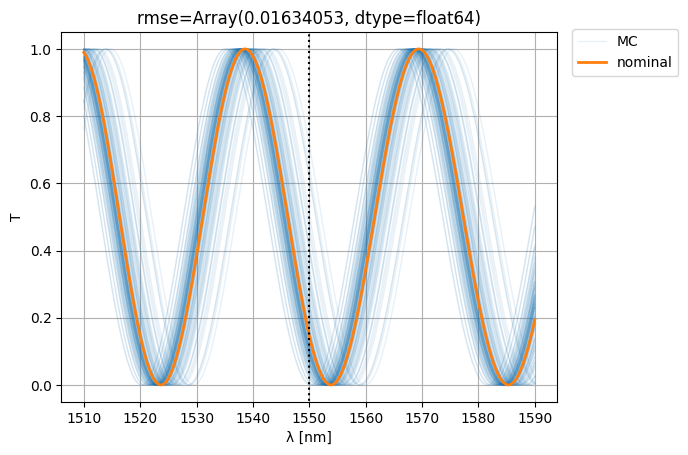Layout Aware Monte Carlo with GDSFactory#
Towards layout-aware optimization and monte-carlo simulations
import itertools
import json
import os
import sys
from functools import partial
from typing import List
import gdsfactory as gf # conda install gdsfactory
import jax
import jax.example_libraries.optimizers as opt
import jax.numpy as jnp
import matplotlib.pyplot as plt
import meow as mw
import numpy as np
import sax
from numpy.fft import fft2, fftfreq, fftshift, ifft2
from tqdm.notebook import tqdm, trange
Simple MZI Layout#
@gf.cell
def simple_mzi():
c = gf.Component()
# components
mmi_in = gf.components.mmi1x2()
mmi_out = gf.components.mmi2x2()
bend = gf.components.bend_euler()
half_delay_straight = gf.components.straight(length=10.0)
# references
mmi_in = c.add_ref(mmi_in, name="mmi_in")
mmi_out = c.add_ref(mmi_out, name="mmi_out")
straight_top1 = c.add_ref(half_delay_straight, name="straight_top1")
straight_top2 = c.add_ref(half_delay_straight, name="straight_top2")
bend_top1 = c.add_ref(bend, name="bend_top1")
bend_top2 = c.add_ref(bend, name="bend_top2").dmirror()
bend_top3 = c.add_ref(bend, name="bend_top3").dmirror()
bend_top4 = c.add_ref(bend, name="bend_top4")
bend_btm1 = c.add_ref(bend, name="bend_btm1").dmirror()
bend_btm2 = c.add_ref(bend, name="bend_btm2")
bend_btm3 = c.add_ref(bend, name="bend_btm3")
bend_btm4 = c.add_ref(bend, name="bend_btm4").dmirror()
# connections
bend_top1.connect("o1", mmi_in.ports["o2"])
straight_top1.connect("o1", bend_top1.ports["o2"])
bend_top2.connect("o1", straight_top1.ports["o2"])
bend_top3.connect("o1", bend_top2.ports["o2"])
straight_top2.connect("o1", bend_top3.ports["o2"])
bend_top4.connect("o1", straight_top2.ports["o2"])
bend_btm1.connect("o1", mmi_in.ports["o3"])
bend_btm2.connect("o1", bend_btm1.ports["o2"])
bend_btm3.connect("o1", bend_btm2.ports["o2"])
bend_btm4.connect("o1", bend_btm3.ports["o2"])
mmi_out.connect("o1", bend_btm4.ports["o2"])
# ports
c.add_port(
"o1",
port=mmi_in.ports["o1"],
)
c.add_port("o2", port=mmi_out.ports["o3"])
c.add_port("o3", port=mmi_out.ports["o4"])
return c
mzi = simple_mzi()
mzi
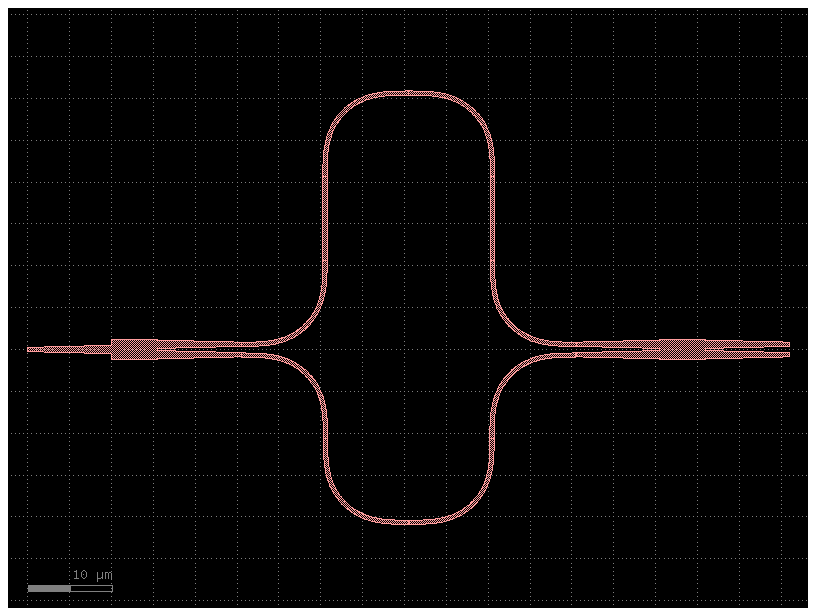
Simulate MZI#
We used the following components to construct the MZI circuit:
mmi1x2
mmi2x2
straight
bend_euler
We need a model for each of those components to be able to simulate the circuit with SAX. Let’s create some dummy models for now.
def mmi1x2():
S = {
("o1", "o2"): 0.5**0.5,
("o1", "o3"): 0.5**0.5,
}
return sax.reciprocal(S)
def mmi2x2():
S = {
("o1", "o3"): 0.5**0.5,
("o1", "o4"): 1j * 0.5**0.5,
("o2", "o3"): 1j * 0.5**0.5,
("o2", "o4"): 0.5**0.5,
}
return sax.reciprocal(S)
def straight(length=10.0, width=0.5):
S = {("o1", "o2"): 1.0} # we'll improve this model later!
return sax.reciprocal(S)
def bend_euler(length=10.0, width=0.5, dy=10.0, radius_min=7, radius=10):
return straight(length=length, width=width) # stub with straight for now
Let’s create a SAX circuit with our very simple placeholder models:
models = {
"mmi1x2": mmi1x2,
"mmi2x2": mmi2x2,
"straight": straight,
"bend_euler": bend_euler,
}
mzi1, _ = sax.circuit(mzi.get_netlist(recursive=True), models=models)
?mzi1
the resulting circuit is just a model function on its own! Hence, calling it will give the result:
mzi1()
{('o1', 'o1'): Array(0.+0.j, dtype=complex128),
('o1', 'o2'): Array(0.5+0.5j, dtype=complex128),
('o1', 'o3'): Array(0.5+0.5j, dtype=complex128),
('o2', 'o1'): Array(0.5+0.5j, dtype=complex128),
('o2', 'o2'): Array(0.+0.j, dtype=complex128),
('o2', 'o3'): Array(0.+0.j, dtype=complex128),
('o3', 'o1'): Array(0.5+0.5j, dtype=complex128),
('o3', 'o2'): Array(0.+0.j, dtype=complex128),
('o3', 'o3'): Array(0.+0.j, dtype=complex128)}
Waveguide Model#
Our waveguide model is not very good (it just has 100% transmission and no phase). Let’s do something about the phase calculation. To do this, we need to find the effective index of the waveguide in relation to its parameters. We can use meow to obtain the waveguide effective index. Let’s first create a find_waveguide_modes:
def find_waveguide_modes(
wl: float = 1.55,
n_box: float = 1.4,
n_clad: float = 1.4,
n_core: float = 3.4,
t_slab: float = 0.1,
t_soi: float = 0.22,
w_core: float = 0.45,
du=0.02,
n_modes: int = 10,
cache_path: str = "modes",
replace_cached: bool = False,
):
length = 10.0
delta = 10 * du
env = mw.Environment(wl=wl)
cache_path = os.path.abspath(cache_path)
os.makedirs(cache_path, exist_ok=True)
fn = f"{wl=:.2f}-{n_box=:.2f}-{n_clad=:.2f}-{n_core=:.2f}-{t_slab=:.3f}-{t_soi=:.3f}-{w_core=:.3f}-{du=:.3f}-{n_modes=}.json"
path = os.path.join(cache_path, fn)
if not replace_cached and os.path.exists(path):
return [mw.Mode.model_validate(mode) for mode in json.load(open(path, "r"))]
# fmt: off
m_core = mw.SampledMaterial(name="slab", n=np.asarray([n_core, n_core]), params={"wl": np.asarray([1.0, 2.0])}, meta={"color": (0.9, 0, 0, 0.9)})
m_clad = mw.SampledMaterial(name="clad", n=np.asarray([n_clad, n_clad]), params={"wl": np.asarray([1.0, 2.0])})
m_box = mw.SampledMaterial(name="box", n=np.asarray([n_box, n_box]), params={"wl": np.asarray([1.0, 2.0])})
box = mw.Structure(material=m_box, geometry=mw.Box(x_min=- 2 * w_core - delta, x_max= 2 * w_core + delta, y_min=- 2 * t_soi - delta, y_max=0.0, z_min=0.0, z_max=length))
slab = mw.Structure(material=m_core, geometry=mw.Box(x_min=-2 * w_core - delta, x_max=2 * w_core + delta, y_min=0.0, y_max=t_slab, z_min=0.0, z_max=length))
clad = mw.Structure(material=m_clad, geometry=mw.Box(x_min=-2 * w_core - delta, x_max=2 * w_core + delta, y_min=0, y_max=3 * t_soi + delta, z_min=0.0, z_max=length))
core = mw.Structure(material=m_core, geometry=mw.Box(x_min=-w_core / 2, x_max=w_core / 2, y_min=0.0, y_max=t_soi, z_min=0.0, z_max=length))
cell = mw.Cell(structures=[box, clad, slab, core], mesh=mw.Mesh2D( x=np.arange(-2*w_core, 2*w_core, du), y=np.arange(-2*t_soi, 3*t_soi, du), ), z_min=0.0, z_max=10.0)
cross_section = mw.CrossSection.from_cell(cell=cell, env=env)
modes = mw.compute_modes(cross_section, num_modes=n_modes)
# fmt: on
json.dump([json.loads(mode.json()) for mode in modes], open(path, "w"))
return modes
We can also create a rudimentary model for the silicon refractive index:
def silicon_index(wl):
"""a rudimentary silicon refractive index model"""
a, b = 0.2411478522088102, 3.3229394315868976
return a / wl + b
We can now easily calculate the modes of a strip waveguide:
modes = find_waveguide_modes(wl=1.5, n_core=silicon_index(wl=1.5))
/tmp/ipykernel_2026/2584847070.py:38: PydanticDeprecatedSince20: The `json` method is deprecated; use `model_dump_json` instead. Deprecated in Pydantic V2.0 to be removed in V3.0. See Pydantic V2 Migration Guide at https://errors.pydantic.dev/2.10/migration/
json.dump([json.loads(mode.json()) for mode in modes], open(path, "w"))
The fundamental mode is the mode with index 0:
mw.visualize(modes[0])
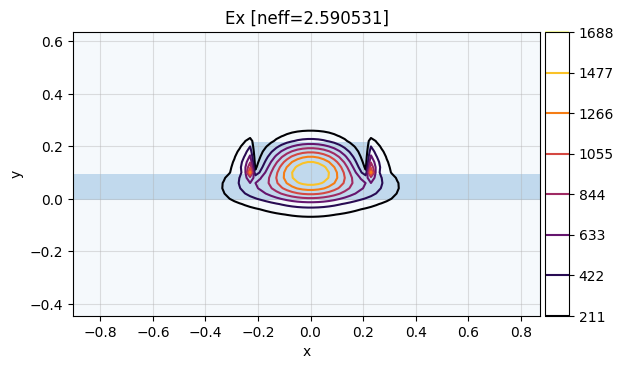
wavelengths, widths = np.mgrid[1.5:1.6:10j, 0.4:0.6:5j]
neffs = np.zeros_like(wavelengths)
neffs_ = neffs.ravel()
for i, (wl, w) in enumerate(zip(tqdm(wavelengths.ravel()), widths.ravel())):
modes = find_waveguide_modes(
wl=wl, n_core=silicon_index(wl), w_core=w, replace_cached=False
)
neffs_[i] = np.real(modes[0].neff)
/tmp/ipykernel_2026/2584847070.py:38: PydanticDeprecatedSince20: The `json` method is deprecated; use `model_dump_json` instead. Deprecated in Pydantic V2.0 to be removed in V3.0. See Pydantic V2 Migration Guide at https://errors.pydantic.dev/2.10/migration/
json.dump([json.loads(mode.json()) for mode in modes], open(path, "w"))
/tmp/ipykernel_2026/2584847070.py:38: PydanticDeprecatedSince20: The `json` method is deprecated; use `model_dump_json` instead. Deprecated in Pydantic V2.0 to be removed in V3.0. See Pydantic V2 Migration Guide at https://errors.pydantic.dev/2.10/migration/
json.dump([json.loads(mode.json()) for mode in modes], open(path, "w"))
/tmp/ipykernel_2026/2584847070.py:38: PydanticDeprecatedSince20: The `json` method is deprecated; use `model_dump_json` instead. Deprecated in Pydantic V2.0 to be removed in V3.0. See Pydantic V2 Migration Guide at https://errors.pydantic.dev/2.10/migration/
json.dump([json.loads(mode.json()) for mode in modes], open(path, "w"))
/tmp/ipykernel_2026/2584847070.py:38: PydanticDeprecatedSince20: The `json` method is deprecated; use `model_dump_json` instead. Deprecated in Pydantic V2.0 to be removed in V3.0. See Pydantic V2 Migration Guide at https://errors.pydantic.dev/2.10/migration/
json.dump([json.loads(mode.json()) for mode in modes], open(path, "w"))
/tmp/ipykernel_2026/2584847070.py:38: PydanticDeprecatedSince20: The `json` method is deprecated; use `model_dump_json` instead. Deprecated in Pydantic V2.0 to be removed in V3.0. See Pydantic V2 Migration Guide at https://errors.pydantic.dev/2.10/migration/
json.dump([json.loads(mode.json()) for mode in modes], open(path, "w"))
/tmp/ipykernel_2026/2584847070.py:38: PydanticDeprecatedSince20: The `json` method is deprecated; use `model_dump_json` instead. Deprecated in Pydantic V2.0 to be removed in V3.0. See Pydantic V2 Migration Guide at https://errors.pydantic.dev/2.10/migration/
json.dump([json.loads(mode.json()) for mode in modes], open(path, "w"))
/tmp/ipykernel_2026/2584847070.py:38: PydanticDeprecatedSince20: The `json` method is deprecated; use `model_dump_json` instead. Deprecated in Pydantic V2.0 to be removed in V3.0. See Pydantic V2 Migration Guide at https://errors.pydantic.dev/2.10/migration/
json.dump([json.loads(mode.json()) for mode in modes], open(path, "w"))
/tmp/ipykernel_2026/2584847070.py:38: PydanticDeprecatedSince20: The `json` method is deprecated; use `model_dump_json` instead. Deprecated in Pydantic V2.0 to be removed in V3.0. See Pydantic V2 Migration Guide at https://errors.pydantic.dev/2.10/migration/
json.dump([json.loads(mode.json()) for mode in modes], open(path, "w"))
/tmp/ipykernel_2026/2584847070.py:38: PydanticDeprecatedSince20: The `json` method is deprecated; use `model_dump_json` instead. Deprecated in Pydantic V2.0 to be removed in V3.0. See Pydantic V2 Migration Guide at https://errors.pydantic.dev/2.10/migration/
json.dump([json.loads(mode.json()) for mode in modes], open(path, "w"))
/tmp/ipykernel_2026/2584847070.py:38: PydanticDeprecatedSince20: The `json` method is deprecated; use `model_dump_json` instead. Deprecated in Pydantic V2.0 to be removed in V3.0. See Pydantic V2 Migration Guide at https://errors.pydantic.dev/2.10/migration/
json.dump([json.loads(mode.json()) for mode in modes], open(path, "w"))
/tmp/ipykernel_2026/2584847070.py:38: PydanticDeprecatedSince20: The `json` method is deprecated; use `model_dump_json` instead. Deprecated in Pydantic V2.0 to be removed in V3.0. See Pydantic V2 Migration Guide at https://errors.pydantic.dev/2.10/migration/
json.dump([json.loads(mode.json()) for mode in modes], open(path, "w"))
/tmp/ipykernel_2026/2584847070.py:38: PydanticDeprecatedSince20: The `json` method is deprecated; use `model_dump_json` instead. Deprecated in Pydantic V2.0 to be removed in V3.0. See Pydantic V2 Migration Guide at https://errors.pydantic.dev/2.10/migration/
json.dump([json.loads(mode.json()) for mode in modes], open(path, "w"))
/tmp/ipykernel_2026/2584847070.py:38: PydanticDeprecatedSince20: The `json` method is deprecated; use `model_dump_json` instead. Deprecated in Pydantic V2.0 to be removed in V3.0. See Pydantic V2 Migration Guide at https://errors.pydantic.dev/2.10/migration/
json.dump([json.loads(mode.json()) for mode in modes], open(path, "w"))
/tmp/ipykernel_2026/2584847070.py:38: PydanticDeprecatedSince20: The `json` method is deprecated; use `model_dump_json` instead. Deprecated in Pydantic V2.0 to be removed in V3.0. See Pydantic V2 Migration Guide at https://errors.pydantic.dev/2.10/migration/
json.dump([json.loads(mode.json()) for mode in modes], open(path, "w"))
/tmp/ipykernel_2026/2584847070.py:38: PydanticDeprecatedSince20: The `json` method is deprecated; use `model_dump_json` instead. Deprecated in Pydantic V2.0 to be removed in V3.0. See Pydantic V2 Migration Guide at https://errors.pydantic.dev/2.10/migration/
json.dump([json.loads(mode.json()) for mode in modes], open(path, "w"))
/tmp/ipykernel_2026/2584847070.py:38: PydanticDeprecatedSince20: The `json` method is deprecated; use `model_dump_json` instead. Deprecated in Pydantic V2.0 to be removed in V3.0. See Pydantic V2 Migration Guide at https://errors.pydantic.dev/2.10/migration/
json.dump([json.loads(mode.json()) for mode in modes], open(path, "w"))
/tmp/ipykernel_2026/2584847070.py:38: PydanticDeprecatedSince20: The `json` method is deprecated; use `model_dump_json` instead. Deprecated in Pydantic V2.0 to be removed in V3.0. See Pydantic V2 Migration Guide at https://errors.pydantic.dev/2.10/migration/
json.dump([json.loads(mode.json()) for mode in modes], open(path, "w"))
/tmp/ipykernel_2026/2584847070.py:38: PydanticDeprecatedSince20: The `json` method is deprecated; use `model_dump_json` instead. Deprecated in Pydantic V2.0 to be removed in V3.0. See Pydantic V2 Migration Guide at https://errors.pydantic.dev/2.10/migration/
json.dump([json.loads(mode.json()) for mode in modes], open(path, "w"))
/tmp/ipykernel_2026/2584847070.py:38: PydanticDeprecatedSince20: The `json` method is deprecated; use `model_dump_json` instead. Deprecated in Pydantic V2.0 to be removed in V3.0. See Pydantic V2 Migration Guide at https://errors.pydantic.dev/2.10/migration/
json.dump([json.loads(mode.json()) for mode in modes], open(path, "w"))
/tmp/ipykernel_2026/2584847070.py:38: PydanticDeprecatedSince20: The `json` method is deprecated; use `model_dump_json` instead. Deprecated in Pydantic V2.0 to be removed in V3.0. See Pydantic V2 Migration Guide at https://errors.pydantic.dev/2.10/migration/
json.dump([json.loads(mode.json()) for mode in modes], open(path, "w"))
/tmp/ipykernel_2026/2584847070.py:38: PydanticDeprecatedSince20: The `json` method is deprecated; use `model_dump_json` instead. Deprecated in Pydantic V2.0 to be removed in V3.0. See Pydantic V2 Migration Guide at https://errors.pydantic.dev/2.10/migration/
json.dump([json.loads(mode.json()) for mode in modes], open(path, "w"))
/tmp/ipykernel_2026/2584847070.py:38: PydanticDeprecatedSince20: The `json` method is deprecated; use `model_dump_json` instead. Deprecated in Pydantic V2.0 to be removed in V3.0. See Pydantic V2 Migration Guide at https://errors.pydantic.dev/2.10/migration/
json.dump([json.loads(mode.json()) for mode in modes], open(path, "w"))
/tmp/ipykernel_2026/2584847070.py:38: PydanticDeprecatedSince20: The `json` method is deprecated; use `model_dump_json` instead. Deprecated in Pydantic V2.0 to be removed in V3.0. See Pydantic V2 Migration Guide at https://errors.pydantic.dev/2.10/migration/
json.dump([json.loads(mode.json()) for mode in modes], open(path, "w"))
/tmp/ipykernel_2026/2584847070.py:38: PydanticDeprecatedSince20: The `json` method is deprecated; use `model_dump_json` instead. Deprecated in Pydantic V2.0 to be removed in V3.0. See Pydantic V2 Migration Guide at https://errors.pydantic.dev/2.10/migration/
json.dump([json.loads(mode.json()) for mode in modes], open(path, "w"))
/tmp/ipykernel_2026/2584847070.py:38: PydanticDeprecatedSince20: The `json` method is deprecated; use `model_dump_json` instead. Deprecated in Pydantic V2.0 to be removed in V3.0. See Pydantic V2 Migration Guide at https://errors.pydantic.dev/2.10/migration/
json.dump([json.loads(mode.json()) for mode in modes], open(path, "w"))
/tmp/ipykernel_2026/2584847070.py:38: PydanticDeprecatedSince20: The `json` method is deprecated; use `model_dump_json` instead. Deprecated in Pydantic V2.0 to be removed in V3.0. See Pydantic V2 Migration Guide at https://errors.pydantic.dev/2.10/migration/
json.dump([json.loads(mode.json()) for mode in modes], open(path, "w"))
/tmp/ipykernel_2026/2584847070.py:38: PydanticDeprecatedSince20: The `json` method is deprecated; use `model_dump_json` instead. Deprecated in Pydantic V2.0 to be removed in V3.0. See Pydantic V2 Migration Guide at https://errors.pydantic.dev/2.10/migration/
json.dump([json.loads(mode.json()) for mode in modes], open(path, "w"))
/tmp/ipykernel_2026/2584847070.py:38: PydanticDeprecatedSince20: The `json` method is deprecated; use `model_dump_json` instead. Deprecated in Pydantic V2.0 to be removed in V3.0. See Pydantic V2 Migration Guide at https://errors.pydantic.dev/2.10/migration/
json.dump([json.loads(mode.json()) for mode in modes], open(path, "w"))
/tmp/ipykernel_2026/2584847070.py:38: PydanticDeprecatedSince20: The `json` method is deprecated; use `model_dump_json` instead. Deprecated in Pydantic V2.0 to be removed in V3.0. See Pydantic V2 Migration Guide at https://errors.pydantic.dev/2.10/migration/
json.dump([json.loads(mode.json()) for mode in modes], open(path, "w"))
/tmp/ipykernel_2026/2584847070.py:38: PydanticDeprecatedSince20: The `json` method is deprecated; use `model_dump_json` instead. Deprecated in Pydantic V2.0 to be removed in V3.0. See Pydantic V2 Migration Guide at https://errors.pydantic.dev/2.10/migration/
json.dump([json.loads(mode.json()) for mode in modes], open(path, "w"))
/tmp/ipykernel_2026/2584847070.py:38: PydanticDeprecatedSince20: The `json` method is deprecated; use `model_dump_json` instead. Deprecated in Pydantic V2.0 to be removed in V3.0. See Pydantic V2 Migration Guide at https://errors.pydantic.dev/2.10/migration/
json.dump([json.loads(mode.json()) for mode in modes], open(path, "w"))
/tmp/ipykernel_2026/2584847070.py:38: PydanticDeprecatedSince20: The `json` method is deprecated; use `model_dump_json` instead. Deprecated in Pydantic V2.0 to be removed in V3.0. See Pydantic V2 Migration Guide at https://errors.pydantic.dev/2.10/migration/
json.dump([json.loads(mode.json()) for mode in modes], open(path, "w"))
/tmp/ipykernel_2026/2584847070.py:38: PydanticDeprecatedSince20: The `json` method is deprecated; use `model_dump_json` instead. Deprecated in Pydantic V2.0 to be removed in V3.0. See Pydantic V2 Migration Guide at https://errors.pydantic.dev/2.10/migration/
json.dump([json.loads(mode.json()) for mode in modes], open(path, "w"))
/tmp/ipykernel_2026/2584847070.py:38: PydanticDeprecatedSince20: The `json` method is deprecated; use `model_dump_json` instead. Deprecated in Pydantic V2.0 to be removed in V3.0. See Pydantic V2 Migration Guide at https://errors.pydantic.dev/2.10/migration/
json.dump([json.loads(mode.json()) for mode in modes], open(path, "w"))
/tmp/ipykernel_2026/2584847070.py:38: PydanticDeprecatedSince20: The `json` method is deprecated; use `model_dump_json` instead. Deprecated in Pydantic V2.0 to be removed in V3.0. See Pydantic V2 Migration Guide at https://errors.pydantic.dev/2.10/migration/
json.dump([json.loads(mode.json()) for mode in modes], open(path, "w"))
/tmp/ipykernel_2026/2584847070.py:38: PydanticDeprecatedSince20: The `json` method is deprecated; use `model_dump_json` instead. Deprecated in Pydantic V2.0 to be removed in V3.0. See Pydantic V2 Migration Guide at https://errors.pydantic.dev/2.10/migration/
json.dump([json.loads(mode.json()) for mode in modes], open(path, "w"))
/tmp/ipykernel_2026/2584847070.py:38: PydanticDeprecatedSince20: The `json` method is deprecated; use `model_dump_json` instead. Deprecated in Pydantic V2.0 to be removed in V3.0. See Pydantic V2 Migration Guide at https://errors.pydantic.dev/2.10/migration/
json.dump([json.loads(mode.json()) for mode in modes], open(path, "w"))
/tmp/ipykernel_2026/2584847070.py:38: PydanticDeprecatedSince20: The `json` method is deprecated; use `model_dump_json` instead. Deprecated in Pydantic V2.0 to be removed in V3.0. See Pydantic V2 Migration Guide at https://errors.pydantic.dev/2.10/migration/
json.dump([json.loads(mode.json()) for mode in modes], open(path, "w"))
/tmp/ipykernel_2026/2584847070.py:38: PydanticDeprecatedSince20: The `json` method is deprecated; use `model_dump_json` instead. Deprecated in Pydantic V2.0 to be removed in V3.0. See Pydantic V2 Migration Guide at https://errors.pydantic.dev/2.10/migration/
json.dump([json.loads(mode.json()) for mode in modes], open(path, "w"))
/tmp/ipykernel_2026/2584847070.py:38: PydanticDeprecatedSince20: The `json` method is deprecated; use `model_dump_json` instead. Deprecated in Pydantic V2.0 to be removed in V3.0. See Pydantic V2 Migration Guide at https://errors.pydantic.dev/2.10/migration/
json.dump([json.loads(mode.json()) for mode in modes], open(path, "w"))
/tmp/ipykernel_2026/2584847070.py:38: PydanticDeprecatedSince20: The `json` method is deprecated; use `model_dump_json` instead. Deprecated in Pydantic V2.0 to be removed in V3.0. See Pydantic V2 Migration Guide at https://errors.pydantic.dev/2.10/migration/
json.dump([json.loads(mode.json()) for mode in modes], open(path, "w"))
/tmp/ipykernel_2026/2584847070.py:38: PydanticDeprecatedSince20: The `json` method is deprecated; use `model_dump_json` instead. Deprecated in Pydantic V2.0 to be removed in V3.0. See Pydantic V2 Migration Guide at https://errors.pydantic.dev/2.10/migration/
json.dump([json.loads(mode.json()) for mode in modes], open(path, "w"))
/tmp/ipykernel_2026/2584847070.py:38: PydanticDeprecatedSince20: The `json` method is deprecated; use `model_dump_json` instead. Deprecated in Pydantic V2.0 to be removed in V3.0. See Pydantic V2 Migration Guide at https://errors.pydantic.dev/2.10/migration/
json.dump([json.loads(mode.json()) for mode in modes], open(path, "w"))
/tmp/ipykernel_2026/2584847070.py:38: PydanticDeprecatedSince20: The `json` method is deprecated; use `model_dump_json` instead. Deprecated in Pydantic V2.0 to be removed in V3.0. See Pydantic V2 Migration Guide at https://errors.pydantic.dev/2.10/migration/
json.dump([json.loads(mode.json()) for mode in modes], open(path, "w"))
/tmp/ipykernel_2026/2584847070.py:38: PydanticDeprecatedSince20: The `json` method is deprecated; use `model_dump_json` instead. Deprecated in Pydantic V2.0 to be removed in V3.0. See Pydantic V2 Migration Guide at https://errors.pydantic.dev/2.10/migration/
json.dump([json.loads(mode.json()) for mode in modes], open(path, "w"))
/tmp/ipykernel_2026/2584847070.py:38: PydanticDeprecatedSince20: The `json` method is deprecated; use `model_dump_json` instead. Deprecated in Pydantic V2.0 to be removed in V3.0. See Pydantic V2 Migration Guide at https://errors.pydantic.dev/2.10/migration/
json.dump([json.loads(mode.json()) for mode in modes], open(path, "w"))
/tmp/ipykernel_2026/2584847070.py:38: PydanticDeprecatedSince20: The `json` method is deprecated; use `model_dump_json` instead. Deprecated in Pydantic V2.0 to be removed in V3.0. See Pydantic V2 Migration Guide at https://errors.pydantic.dev/2.10/migration/
json.dump([json.loads(mode.json()) for mode in modes], open(path, "w"))
/tmp/ipykernel_2026/2584847070.py:38: PydanticDeprecatedSince20: The `json` method is deprecated; use `model_dump_json` instead. Deprecated in Pydantic V2.0 to be removed in V3.0. See Pydantic V2 Migration Guide at https://errors.pydantic.dev/2.10/migration/
json.dump([json.loads(mode.json()) for mode in modes], open(path, "w"))
This results in the following effective indices:
_wls = np.unique(wavelengths.ravel())
_widths = np.unique(widths.ravel())
plt.figure(figsize=(8, 3))
plt.plot(_wls * 1000, neffs)
plt.ylabel("neff")
plt.xlabel("λ [nm]")
plt.title("Effective Index")
plt.grid(True)
plt.figlegend(
[f"{w=:.2f}um" for w in _widths], ncol=len(widths), bbox_to_anchor=(0.95, -0.05)
)
plt.show()
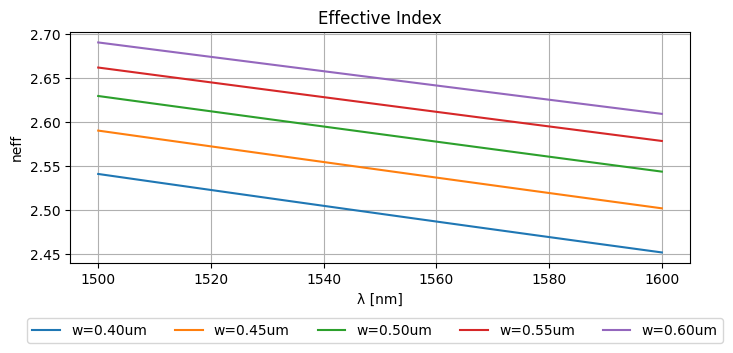
We can do a grid interpolation on those effective indices:
_grid = [jnp.sort(jnp.unique(wavelengths)), jnp.sort(jnp.unique(widths))]
_data = jnp.asarray(neffs)
@jax.jit
def _get_coordinate(arr1d: jnp.ndarray, value: jnp.ndarray):
return jnp.interp(value, arr1d, jnp.arange(arr1d.shape[0]))
@jax.jit
def _get_coordinates(arrs1d: List[jnp.ndarray], values: jnp.ndarray):
# don't use vmap as arrays in arrs1d could have different shapes...
return jnp.array([_get_coordinate(a, v) for a, v in zip(arrs1d, values)])
@jax.jit
def neff(wl=1.55, width=0.5):
params = jnp.stack(jnp.broadcast_arrays(jnp.asarray(wl), jnp.asarray(width)), 0)
coords = _get_coordinates(_grid, params)
return jax.scipy.ndimage.map_coordinates(_data, coords, 1, mode="nearest")
neff(wl=[1.52, 1.58], width=[0.5, 0.55])
Array([2.61246994, 2.59526173], dtype=float64)
wavelengths_ = np.linspace(wavelengths.min(), wavelengths.max(), 100)
widths_ = np.linspace(widths.min(), widths.max(), 100)
wavelengths_, widths_ = np.meshgrid(wavelengths_, widths_)
neffs_ = neff(wavelengths_, widths_)
plt.figure(figsize=(8, 3))
plt.pcolormesh(wavelengths_ * 1000, widths_, neffs_)
plt.ylabel("neff")
plt.xlabel("λ [nm]")
plt.title("Effective Index")
plt.grid(True)
plt.figlegend(
[f"{w=:.2f}um" for w in _widths], ncol=len(_widths), bbox_to_anchor=(0.95, -0.05)
)
plt.show()
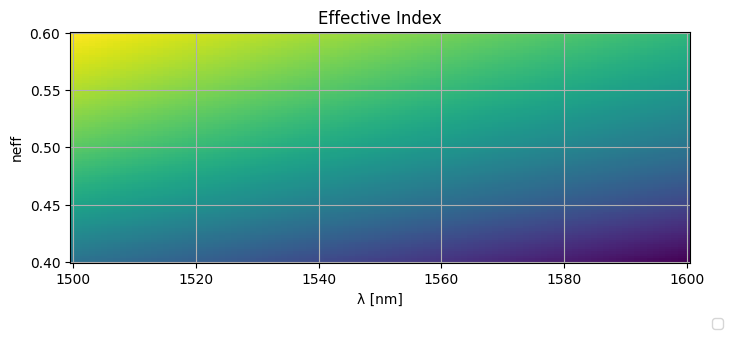
def straight(wl=1.55, length=10.0, width=0.5):
S = {
("o1", "o2"): jnp.exp(2j * np.pi * neff(wl=wl, width=width) / wl * length),
}
return sax.reciprocal(S)
Even though this still is lossless transmission, we’re at least modeling the phase correctly.
straight()
{('o1', 'o2'): Array(-0.38310141-0.92370629j, dtype=complex128),
('o2', 'o1'): Array(-0.38310141-0.92370629j, dtype=complex128)}
Simulate MZI again#
models["straight"] = straight
mzi2, _ = sax.circuit(mzi.get_netlist(recursive=True), models=models)
mzi2()
{('o1', 'o1'): Array(0.+0.j, dtype=complex128),
('o1', 'o2'): Array(0.25085186-0.28844437j, dtype=complex128),
('o1', 'o3'): Array(-0.60638585+0.69725847j, dtype=complex128),
('o2', 'o1'): Array(0.25085186-0.28844437j, dtype=complex128),
('o2', 'o2'): Array(0.+0.j, dtype=complex128),
('o2', 'o3'): Array(0.+0.j, dtype=complex128),
('o3', 'o1'): Array(-0.60638585+0.69725847j, dtype=complex128),
('o3', 'o2'): Array(0.+0.j, dtype=complex128),
('o3', 'o3'): Array(0.+0.j, dtype=complex128)}
wl = jnp.linspace(1.51, 1.59, 1000)
S = mzi2(wl=wl)
plt.plot(wl, abs(S["o1", "o2"]) ** 2)
plt.ylim(-0.05, 1.05)
plt.xlabel("λ [μm]")
plt.ylabel("T")
plt.ylim(-0.05, 1.05)
plt.grid(True)
plt.show()
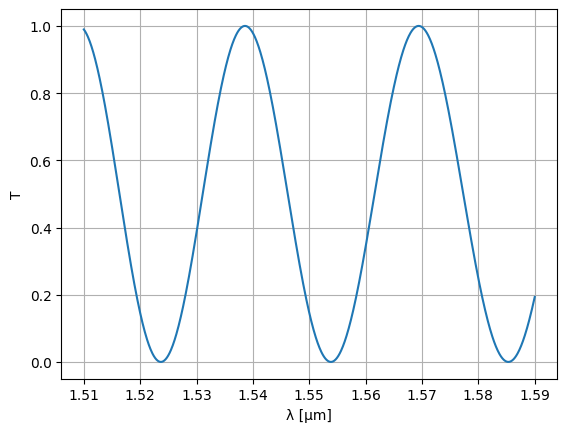
Optimize MZI#
We’d like to optimize an MZI such that one of the minima is at 1550nm. To do this, we need to define a loss function for the circuit at 1550nm. This function should take the parameters that you want to optimize as positional arguments:
@jax.jit
def loss_fn(delta_length):
S = mzi2(
wl=1.55,
straight_top1={"length": delta_length / 2},
straight_top2={"length": delta_length / 2},
)
return jnp.mean(jnp.abs(S["o1", "o2"]) ** 2)
We can use this loss function to define a grad function which works on the parameters of the loss function:
grad_fn = jax.jit(
jax.grad(
loss_fn,
argnums=0, # JAX gradient function for the first positional argument, jitted
)
)
Next, we need to define a JAX optimizer, which on its own is nothing more than three more functions: an initialization function with which to initialize the optimizer state, an update function which will update the optimizer state (and with it the model parameters). The third function that’s being returned will give the model parameters given the optimizer state.
loss_fn(20.0)
Array(0.14612682, dtype=float64)
initial_delta_length = 10.0
init_fn, update_fn, params_fn = opt.adam(step_size=0.1)
state = init_fn(initial_delta_length)
Given all this, a single training step can be defined:
def step_fn(step, state):
params = params_fn(state)
loss = loss_fn(params)
grad = grad_fn(params)
state = update_fn(step, grad, state)
return loss, state
And we can use this step function to start the training of the MZI:
for step in (
pb := trange(300)
): # the first two iterations take a while because the circuit is being jitted...
loss, state = step_fn(step, state)
pb.set_postfix(loss=f"{loss:.6f}")
delta_length = params_fn(state)
delta_length
Array(9.73786976, dtype=float64)
Let’s see what we’ve got over a range of wavelengths:
S = mzi2(
wl=wl,
straight_top1={"length": delta_length / 2},
straight_top2={"length": delta_length / 2},
)
plt.plot(wl * 1e3, abs(S["o1", "o2"]) ** 2)
plt.xlabel("λ [nm]")
plt.ylabel("T")
plt.plot([1550, 1550], [-1, 2], ls=":", color="black")
plt.ylim(-0.05, 1.05)
plt.grid(True)
plt.show()
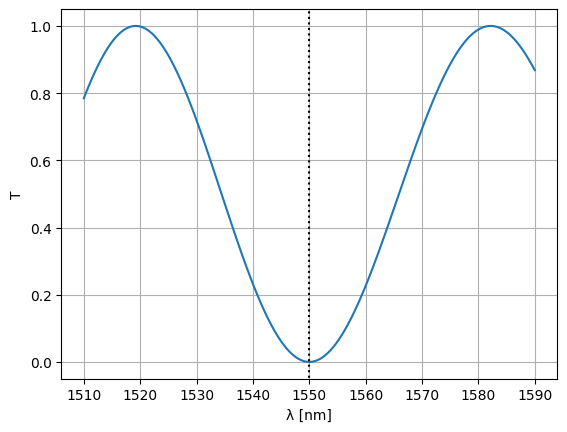
Note that we could’ve just as well optimized the waveguide width:
@jax.jit
def loss_fn(width):
S = mzi2(
wl=1.55,
straight_top1={"width": width},
straight_top2={"width": width},
)
return jnp.mean(jnp.abs(S["o1", "o2"]) ** 2)
grad_fn = jax.jit(
jax.grad(
loss_fn,
argnums=0, # JAX gradient function for the first positional argument, jitted
)
)
initial_width = 0.5
init_fn, update_fn, params_fn = opt.adam(step_size=0.01)
state = init_fn(initial_width)
for step in (
pb := trange(300)
): # the first two iterations take a while because the circuit is being jitted...
loss, state = step_fn(step, state)
pb.set_postfix(loss=f"{loss:.6f}")
optim_width = params_fn(state)
S = Sw = mzi2(
wl=wl,
straight_top1={"width": optim_width},
straight_top2={"width": optim_width},
)
plt.plot(wl * 1e3, abs(S["o1", "o2"]) ** 2)
plt.xlabel("λ [nm]")
plt.ylabel("T")
plt.plot([1550, 1550], [-1, 2], color="black", ls=":")
plt.ylim(-0.05, 1.05)
plt.grid(True)
plt.show()
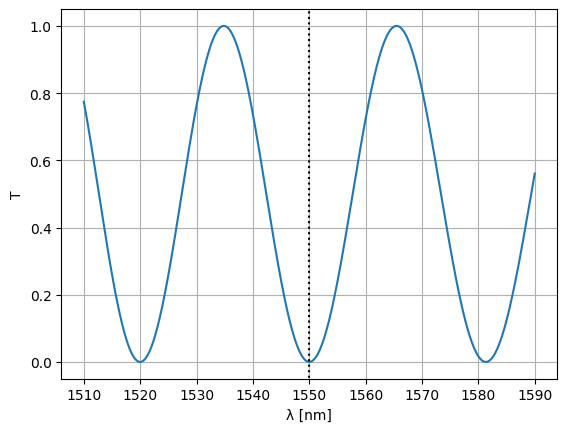
Layout-aware Monte Carlo#
Let’s assume the waveguide width changes with a certain correlation length. We can create a ‘wafermap’ of width variations by randomly varying the width and low pass filtering with a spatial frequency being the inverse of the correlation length (there are probably better ways to do this, but this works for this tutorial).
def create_wafermaps(
placements, correlation_length=1.0, num_maps=1, mean=0.0, std=1.0, seed=None
):
dx = dy = correlation_length / 200
xs = [p["x"] for p in placements.values()]
ys = [p["y"] for p in placements.values()]
xmin, xmax, ymin, ymax = min(xs), max(xs), min(ys), max(ys)
wx, wy = xmax - xmin, ymax - ymin
xmin, xmax, ymin, ymax = xmin - wx, xmax + wx, ymin - wy, ymax + wy
x, y = np.arange(xmin, xmax + dx, dx), np.arange(ymin, ymax + dy, dy)
if seed is None:
r = np.random
else:
r = np.random.RandomState(seed=seed)
W0 = r.randn(num_maps, x.shape[0], y.shape[0])
fx = fftshift(fftfreq(x.shape[0], d=x[1] - x[0]))
fy = fftshift(fftfreq(y.shape[0], d=y[1] - y[0]))
fY, fX = np.meshgrid(fy, fx)
fW = fftshift(fft2(W0))
if correlation_length >= min(x.shape[0], y.shape[0]):
fW = np.zeros_like(fW)
else:
fW = np.where(np.sqrt(fX**2 + fY**2)[None] > 1 / correlation_length, 0, fW)
W = np.abs(fftshift(ifft2(fW))) ** 2
mean_ = W.mean(1, keepdims=True).mean(2, keepdims=True)
std_ = W.std(1, keepdims=True).std(2, keepdims=True)
if (std_ == 0).all():
std_ = 1
W = (W - mean_) / std_
W = W * std + mean
return x, y, W
placements = mzi.get_netlist()["placements"]
xm, ym, wmaps = create_wafermaps(
placements,
correlation_length=100,
mean=0.5,
std=0.002,
num_maps=100,
seed=42,
)
for i, wmap in enumerate(wmaps):
if i > 1:
break
plt.imshow(wmap, cmap="RdBu")
plt.show()
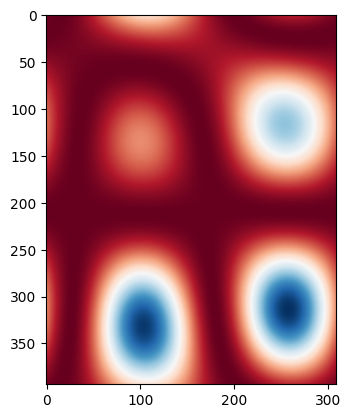
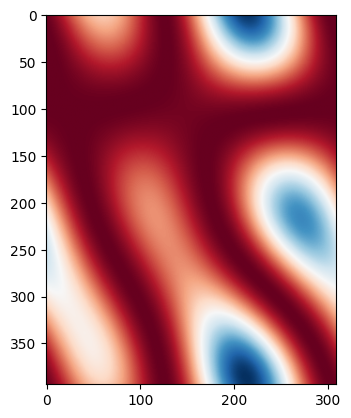
def widths(xw, yw, wmaps, x, y):
_wmap_grid = [xw, yw]
params = jnp.stack(jnp.broadcast_arrays(jnp.asarray(x), jnp.asarray(y)), 0)
coords = _get_coordinates(_wmap_grid, params)
map_coordinates = partial(
jax.scipy.ndimage.map_coordinates, coordinates=coords, order=1, mode="nearest"
)
w = jax.vmap(map_coordinates)(wmaps)
return w
Let’s now sample the MZI width variation on the wafer map (let’s assume a single width variation per point):
mzi_params = sax.get_settings(mzi2)
placements = mzi.get_netlist()["placements"]
width_params = {
k: {"width": widths(xm, ym, wmaps, v["x"], v["y"])}
for k, v in placements.items()
if "width" in mzi_params[k]
}
S0 = mzi2(wl=wl)
S = mzi2(
wl=wl[:, None],
**width_params,
)
ps = plt.plot(wl * 1e3, abs(S["o1", "o2"]) ** 2, color="C0", lw=1, alpha=0.1)
nps = plt.plot(wl * 1e3, abs(S0["o1", "o2"]) ** 2, color="C1", lw=2, alpha=1)
plt.xlabel("λ [nm]")
plt.ylabel("T")
plt.plot([1550, 1550], [-1, 2], color="black", ls=":")
plt.ylim(-0.05, 1.05)
plt.grid(True)
plt.figlegend([*ps[-1:], *nps], ["MC", "nominal"], bbox_to_anchor=(1.1, 0.9))
rmse = jnp.mean(
jnp.abs(jnp.abs(S["o1", "o2"]) ** 2 - jnp.abs(S0["o1", "o2"][:, None]) ** 2) ** 2
)
plt.title(f"{rmse=}")
plt.show()

Compact MZI#
Let’s see if we can improve variability (i.e. the RMSE w.r.t. nominal) by making the MZI more compact:
@gf.cell
def compact_mzi():
c = gf.Component()
# instances
mmi_in = gf.components.mmi1x2()
mmi_out = gf.components.mmi2x2()
bend = gf.components.bend_euler()
half_delay_straight = gf.components.straight()
middle_straight = gf.components.straight(length=6.0)
half_middle_straight = gf.components.straight(3.0)
# references (sax convention: vars ending in underscore are references)
mmi_in = c.add_ref(mmi_in, name="mmi_in")
bend_top1 = c.add_ref(bend, name="bend_top1")
straight_top1 = c.add_ref(half_delay_straight, name="straight_top1")
bend_top2 = c.add_ref(bend, name="bend_top2").dmirror()
straight_top2 = c.add_ref(middle_straight, name="straight_top2")
bend_top3 = c.add_ref(bend, name="bend_top3").dmirror()
straight_top3 = c.add_ref(half_delay_straight, name="straight_top3")
bend_top4 = c.add_ref(bend, name="bend_top4")
straight_btm1 = c.add_ref(half_middle_straight, name="straight_btm1")
bend_btm1 = c.add_ref(bend, name="bend_btm1")
bend_btm2 = c.add_ref(bend, name="bend_btm2").dmirror()
bend_btm3 = c.add_ref(bend, name="bend_btm3").dmirror()
bend_btm4 = c.add_ref(bend, name="bend_btm4")
straight_btm2 = c.add_ref(half_middle_straight, name="straight_btm2")
mmi_out = c.add_ref(mmi_out, name="mmi_out")
# connections
bend_top1.connect("o1", mmi_in.ports["o2"])
straight_top1.connect("o1", bend_top1.ports["o2"])
bend_top2.connect("o1", straight_top1.ports["o2"])
straight_top2.connect("o1", bend_top2.ports["o2"])
bend_top3.connect("o1", straight_top2.ports["o2"])
straight_top3.connect("o1", bend_top3.ports["o2"])
bend_top4.connect("o1", straight_top3.ports["o2"])
straight_btm1.connect("o1", mmi_in.ports["o3"])
bend_btm1.connect("o1", straight_btm1.ports["o2"])
bend_btm2.connect("o1", bend_btm1.ports["o2"])
bend_btm3.connect("o1", bend_btm2.ports["o2"])
bend_btm4.connect("o1", bend_btm3.ports["o2"])
straight_btm2.connect("o1", bend_btm4.ports["o2"])
mmi_out.connect("o1", straight_btm2.ports["o2"])
# ports
c.add_port(
"o1",
port=mmi_in.ports["o1"],
)
c.add_port("o2", port=mmi_out.ports["o3"])
c.add_port("o3", port=mmi_out.ports["o4"])
return c
compact_mzi1 = compact_mzi()
compact_mzi1
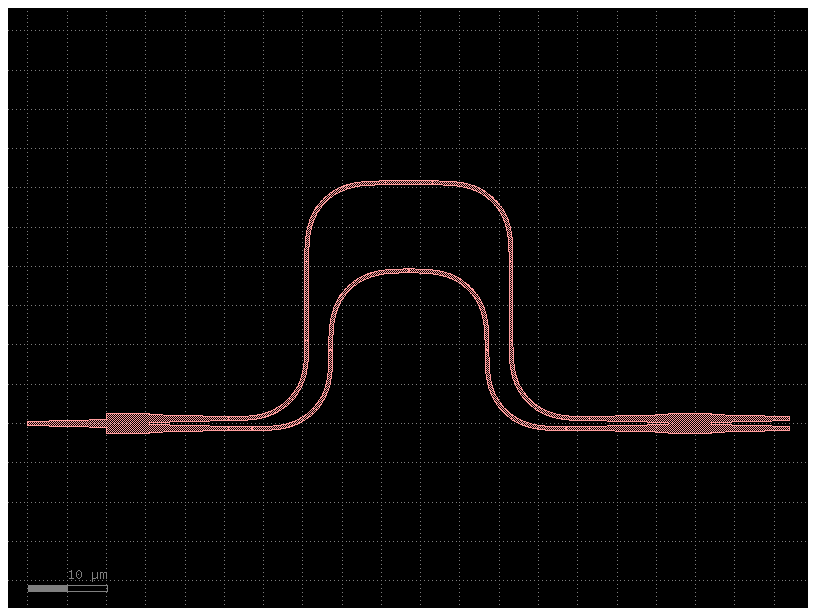
placements = compact_mzi1.get_netlist()["placements"]
mzi3, _ = sax.circuit(compact_mzi1.get_netlist(recursive=True), models=models)
mzi3()
{('o1', 'o1'): Array(0.+0.j, dtype=complex128),
('o1', 'o2'): Array(0.27263693-0.26794761j, dtype=complex128),
('o1', 'o3'): Array(-0.65904702+0.64771151j, dtype=complex128),
('o2', 'o1'): Array(0.27263693-0.26794761j, dtype=complex128),
('o2', 'o2'): Array(0.+0.j, dtype=complex128),
('o2', 'o3'): Array(0.+0.j, dtype=complex128),
('o3', 'o1'): Array(-0.65904702+0.64771151j, dtype=complex128),
('o3', 'o2'): Array(0.+0.j, dtype=complex128),
('o3', 'o3'): Array(0.+0.j, dtype=complex128)}
mzi_params = sax.get_settings(mzi3)
placements = compact_mzi1.get_netlist()["placements"]
width_params = {
k: {"width": widths(xm, ym, wmaps, v["x"], v["y"])}
for k, v in placements.items()
if "width" in mzi_params[k]
}
S0 = mzi3(wl=wl)
S = mzi3(
wl=wl[:, None],
**width_params,
)
ps = plt.plot(wl * 1e3, abs(S["o1", "o2"]) ** 2, color="C0", lw=1, alpha=0.1)
nps = plt.plot(wl * 1e3, abs(S0["o1", "o2"]) ** 2, color="C1", lw=2, alpha=1)
plt.xlabel("λ [nm]")
plt.ylabel("T")
plt.plot([1550, 1550], [-1, 2], color="black", ls=":")
plt.ylim(-0.05, 1.05)
plt.grid(True)
plt.figlegend([*ps[-1:], *nps], ["MC", "nominal"], bbox_to_anchor=(1.1, 0.9))
rmse = jnp.mean(
jnp.abs(jnp.abs(S["o1", "o2"]) ** 2 - jnp.abs(S0["o1", "o2"][:, None]) ** 2) ** 2
)
plt.title(f"{rmse=}")
plt.show()
